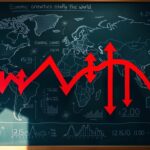Analyzing Trade Fragmentation and Policy Volatility Trends
The global economy has experienced significant shifts over the past decades. Trade fragmentation and policy volatility are two interconnected forces that influence global economics, supply chains, and market stability. In an era marked by regional trade disputes, shifting alliances, and rapid technological change, policymakers and businesses face challenges that directly impact income distribution, consumption patterns, investment strategies, and overall growth. This
This analysis offers a concise yet thorough examination of trade fragmentation and policy volatility, focusing on their causes, effects, interrelations, and potential solutions. It also explores technology’s role and reviews global responses and future trends that are particularly relevant for stakeholders in energy, chemicals, and other strategic sectors.
Understand the Impact of Trade Fragmentation on Global Economics
Trade fragmentation refers to the break-up of global trade into smaller, regional, or sector-specific segments. This division disrupts traditional supply chains, reduces global market integration, and creates disparities in growth and resource allocation. Factors such as protectionist policies, regional trade disputes, and rapid technological advancements lead companies to reconfigure production around localized hubs. The result is a multifaceted economic impact ranging from reduced export volumes to altered fiscal policies. Fragmentation forces firms to restructure supply chains and adjust pricing, inventory management, and overall competitiveness in a volatile market environment.
Analyze How Trade Fragmentation Affects Supply Chains and Markets
Trade fragmentation reshapes production and distribution networks. Companies that once relied on the efficiencies of consolidated global supply chains now face segmented markets and higher production costs. For example, when an automotive manufacturer diversifies its supplier base across regions, it must adapt to local regulatory regimes and resource availability. Although such decentralization can stimulate local innovation, it also increases exposure to regional disruptions caused by political instability or economic downturns. The net effect is heightened market volatility, requiring businesses to adopt more resilient risk management strategies and reexamine long-standing supply chain practices.
Assess the Role of Regional Trade Agreements in Fragmentation
Regional trade agreements (RTAs) like the European Union, NAFTA (now USMCA), and ASEAN serve dual roles in trade fragmentation. These agreements reduce trade barriers among member countries and create zones of economic integration; however, they can also lead to a “splintering” effect by sidelining non-members. Such dynamics may reduce global integration while strengthen The rules about where products come from in these agreements help trade within the region, but they can clash with wider international standards and affect access to global markets, investment, and production plans. Multilateral norms can impact global market access, investment flows, and production strategies.
Consequences of Fragmented Trade Policies
Different sectors experience fragmentation in varied ways. In the energy industry, localized regulations and import barriers can interrupt international supply chains, leading to price volatility. The chemical sector, reliant on a steady influx of raw materials, faces similar challenges when policy volatility disrupts import-export balances. Manufacturing industries contend with increased administrative and transaction costs due to divergent standards, while service-based sectors may better bridge gaps through digital platforms. Thus, understanding industry-specific impacts is crucial for contextualizing policy responses and strategic adaptations.
Identify Key Metrics for Measuring Trade Fragmentation Effects
Measuring trade fragmentation requires effective indicators such as trade-to-GDP ratios, tariff levels, non-tariff barrier indices, lengths of supply chains, and export diversification. Additional measures include volatility indexes, shifts in income distribution, and changes in consumer spending patterns. For example, rising tariff levels and non-tariff measures may correlate with shorter, more localized supply chains and signal a trend toward protectionism. Such metrics assist policymakers in assessing systemic risks, analyzing market equilibrium, and formulating corrective measures to mitigate adverse effects of fragmentation.
Investigate Case Studies of Countries Facing Trade Fragmentation
Real-world case studies provide clarity on the consequences of fragmented trade. In Brazil, regional policies and intra-regional alliances have, at times, isolated its economy and led to challenges such as rising inflation and shortages. Conversely, India has leveraged regional trade agreements alongside digital reforms to support its manufacturing competitiveness despite fragmented trade networks. European nations, particularly those within the core of the EU, generally benefit from harmonized policies, whereas peripheral states may experience greater volatility. These diverse examples illustrate the need for tailored national policies to counteract the negative impacts of fragmentation.
Explore Potential Solutions to Mitigate Fragmentation Challenges
Addressing trade fragmentation requires a multifaceted approach. Policy reforms that harmonize standards, multilateral frameworks complementing regional agreements, and technological integration are key. Advanced analytics, digital platforms, and diversified supply sources can help businesses manage disruptions more effectively. Moreover, a balanced approach to protectionism—safeguarding domestic industries without completely isolating them from global markets—proves critical. Investments in infrastructure that support multimodal trade and real-time monitoring systems further bolster resilience against fragmentation-induced shocks.
Examine the Causes of Policy Volatility in Trade Relations
Policy volatility entails sudden shifts in trade regulations, tariffs, and overall trade policies. Such fluctuations stem largely from political instability, economic cycles, and the rise of protectionism, and they create uncertainty in long-term planning and investment. Volatile policies disturb markets by influencing export flows, production costs, and supply chain dynamics.
Identify Political Factors Contributing to Policy Volatility
Political factors such as unstable governments, populism, and rapid electoral cycles often trigger abrupt policy changes. A change in leadership can lead to the sudden imposition of tariffs or other trade barriers, disrupting established supply chains. Political negotiations, international conflicts, and domestic lobbying efforts further contribute to unpredictable shifts that complicate business operations and long-term economic planning.
Review the Effects of Global Economic Shifts on Trade Policies
Broader economic trends, including recessions, financial crises, and fluctuations in commodity prices, significantly impact trade policies. Economic downturns may force governments to adopt protectionist measures to safeguard domestic industries, such as increasing tariffs or imposing stringent import restrictions, while economic booms tend to encourage more liberal trade practices. These shifts are closely linked to macroeconomic performance and influence policy directions on a global scale.
Analyze the Rise of Protectionism and Its Impact on Stability
The recent resurgence of protectionist policies—implemented through tariffs, quotas, and other barriers—creates short-term relief for domestic sectors but undermines long-term market stability. Such measures can disrupt global trade patterns, incite retaliatory actions, elevate consumer prices, and ultimately stifle economic growth. A stable balance between protecting domestic interests and nurturing global economic integration is essential for maintaining long-term trade stability.
Understand the Role of International Organizations in Policy Changes
International organizations like the WTO and IMF play crucial roles by facilitating dialogue, resolving disputes, and providing policy guidelines. Their mechanisms help promote transparency and uniform standards, preventing abrupt unilateral shifts in national policies. However, national sovereignty can limit their influence, sometimes leading to isolated policy moves that intensify volatility.
Investigate Case Examples of Recent Trade Policy Shifts
Recent examples, such as the US-China tariff wars and Brexit, vividly illustrate how abrupt policy changes can trigger widespread disruptions in global trade. These shifts have led to unpredictable market conditions, supply chain interruptions, and substantial uncertainty for investors. Such cases point out the need for robust risk management and internationally coordinated responses to minimize volatility.
Learn About Strategies to Reduce Volatility in Trade Policies
Strategies to reduce policy volatility include enhancing multilateral coordination, implementing safeguard measures, and adopting phased tariff adjustments. Investment in predictive technology and real-time economic monitoring further enables policymakers and businesses to anticipate and mitigate sudden policy effects. Smoother transitions between successive policy regimes, achieved through stakeholder consultations, serve to stabilize market expectations and build long-term confidence.
Explore the Interconnection Between Trade Fragmentation and Policy Volatility
Trade fragmentation and policy volatility are deeply interconnected. Fragmented trade, by altering local market dynamics, can prompt reactive policy measures that further exacerbate volatility. Conversely, volatile policies can induce businesses to fragment their operations and supply chains. This interrelationship creates a feedback loop, where each factor reinforces the other, deepening overall economic uncertainty.
Discuss How Fragmented Trade Affects Policy Decisions
When trade is highly fragmented, governments often respond with policies tailored to protect specific industries or regions. Such localized policies may include tariffs, subsidies, or other regulatory measures aimed at correcting short-term imbalances. However, these reactive measures can inadvertently increase fragmentation, setting off cycles of further policy adjustments and instability.
Examine Feedback Loops Between Policy Changes and Trade Dynamics
Policy changes can lead to reduced international trade flows, which then prompt additional regulatory measures. These feedback loops render the policy environment unpredictable and complicate long-term planning. For instance, tariff hikes in one country may lead to retaliatory measures elsewhere, further constricting global trade and reinforcing short-term fixes over sustainable, comprehensive reforms.
Identify Historical Examples of Trade and Policy Interdependencies
Historical events, such as the Smoot-Hawley Tariff Act of the 1930s, demonstrate how protectionist policies can trigger prolonged periods of trade fragmentation and economic instability. More recent examples, including tensions between major economies, reveal that even well-integrated trade systems can be vulnerable to sudden policy shifts. These cases highlight the complex interdependencies that must be managed to maintain stable economic relations.
Analyze Systemic Risks Associated With Both Fragmentation and Volatility
High degrees of fragmentation and volatility expose economies to systemic risks, including supply chain disruptions, currency instability, and unpredictable investor behavior. Financial markets react strongly to these uncertainties, as evidenced by volatility measures like the VIX. Long-term, persistent fragmentation and volatility can erode the benefits of international cooperation and lead to uneven economic development across regions.
Investigate Potential Future Trends in This Interconnection
Looking ahead, trends such as digital trade and automation are likely to intensify the interplay between fragmentation and volatility. Emerging markets and technological innovations will force rapid adaptations in trade policies, while the need for coordinated global responses will become more critical. Businesses in sensitive sectors must prepare for increased uncertainty by investing in flexible, technology-driven solutions.
Review Recommendations for Improving Trade Policy Coherence
Experts advocate for enhanced multilateral cooperation, streamlined regulatory standards, and the adoption of adaptive policy frameworks. Harmonizing technical standards and reducing bureaucratic hurdles can mitigate the disruptive effects of fragmentation. Additionally, the use of predictive analytics in policy formulation can provide early warnings of instability, enabling more measured responses that integrate both national and international perspectives.
Investigate the Role of Technology in Trade Fragmentation and Volatility
Technology is a transformative force in international trade. Digital trade platforms, automation, and big data analytics are reshaping transaction processes and supply chain management. These technologies improve transparency, reduce inefficiencies, and enable businesses to quickly respond to market changes. They also present challenges, as new digital silos can form even as global connectivity increases.
Assess How Digital Trade Influences Fragmentation Patterns
Digital trade allows companies to conduct transactions across borders without traditional logistical constraints. While this promotes efficiency, it also encourages localized adaptations to meet specific market demands. The rise of e-commerce, for example, has led businesses to tailor logistics and regulatory compliance to regional conditions, deepening trade fragmentation. Policymakers must strike a balance between benefiting from digital integration and preventing excessive market segmentation.
Examine the Impact of Automation on Global Supply Chains
Automation and robotics reduce dependency on human labor and improve production precision. These technologies enable rapid adjustments in production volumes, smoothing out supply chain disruptions. However, decentralizing production to automated hubs may further fragment supply chains, making them more sensitive to regional policy shifts. Balancing automation with integration is therefore critical to ensure stability.
Understand the Role of Data Analytics in Trade Decision-Making
Data analytics provides real-time insights into market trends, enabling both governments and businesses to anticipate and manage disruptions. By leveraging predictive models and comprehensive analytics, decision-makers can optimize inventory management, adjust production levels, and refine regulatory strategies. This capability creates a feedback loop that helps stabilize markets despite emerging volatility.
Identify Emerging Technologies Shaping International Trade
New technologies such as blockchain, artificial intelligence, and the Internet of Things are reshaping how trade is conducted. Blockchain improves transparency by securely tracking goods, while AI optimizes logistics and predicts market trends. As these technologies mature, they offer pathways for reducing trade barriers and integrating fragmented markets, provided regulatory frameworks keep pace with innovation.
Review Sustainability Efforts in Tech-Driven Trade Transformations
Sustainability is becoming increasingly important as technology transforms trade. Digital supply chains can be optimized to reduce carbon footprints, and smart logistics platforms can lower energy consumption. Integrating environmental metrics into trade practices not only promotes sustainability but also aligns economic activities with global climate goals. This convergence of technology and sustainability represents a promising frontier for reducing fragmentation and enhancing long-term stability.
Analyze the Future Implications of Technology on Trade Policies
As digital technologies evolve, trade policies must adapt accordingly. Innovations such as digital currencies, smart contracts, and decentralized marketplaces offer new ways to streamline transactions but also challenge traditional regulatory frameworks. Future policies will need to prioritize digital security, data privacy, and interoperability, fostering an environment where technological progress and regulatory stability can coexist harmoniously.
Analyze Global Responses to Trade Fragmentation and Policy Volatility
Global responses to these challenges vary widely. Countries and international organizations have adopted a range of policy frameworks and cooperative mechanisms to stabilize markets and promote resilience. These responses emphasize the importance of coordination, technological integration, and adaptive planning as key strategies to mitigate both trade fragmentation and policy volatility.
Study International Cooperation Efforts Addressing Trade Issues
Multilateral organizations such as the WTO, G20, and regional blocs have been central in harmonizing trade policies and resolving disputes. Recent initiatives in regions like the Asia-Pacific have successfully reduced procedural delays and harmonized standards to support more predictable trade conditions. Such cooperative efforts build a framework where diverse economic interests can converge toward stable, mutually beneficial trade policies.
Review Policy Frameworks Implemented by Various Nations
National responses differ, with advanced economies using complex rules often supported by data analysis and gradual policy changes, while emerging markets have more adaptable systems. We have utilized measures like temporary tariff adjustments, emergency subsidies, and digitization of trade processes to mitigate the impact of global disruptions. These national policies illustrate the balance between domestic priorities and international cooperation necessary to maintain trade stability.
Identify Successful Initiatives to Foster Trade Stability
Successful initiatives, like those in ASEAN and the European Union, demonstrate the effectiveness of coordinated trade facilitation programs. The development of streamlined customs procedures and digital tracking systems has enhanced overall trade efficiency. Moreover, public-private partnerships, particularly in countries like South Korea, have led to resilient digital infrastructures that enable real-time data sharing and proactive policy management, building investor confidence and ensuring smoother trade flows.
Examine the Role of NGOs and Diverse Stakeholders in Trade
NGOs and industry groups contribute significantly by advocating for transparency, fair regulations, and inclusiveness in trade policymaking. Political or economic elites do not solely drive regulations, thanks to their independent analyses and stakeholder feedback. This inclusive approach fosters a balanced trade environment that reflects the needs of both businesses and communities.
Investigate Challenges to Global Collaboration in Trade
Despite the benefits of cooperation, global collaboration is often hindered by divergent national interests, political rivalries, and trust deficits. Rapid technological changes and shifting geopolitical alliances further complicate negotiations. Overcoming these challenges requires sustained diplomatic engagement, transparent policy formulation, and the establishment of common regulatory platforms to build a resilient global trade framework.
Explore Innovative Recommendations for Coordinated Responses
Innovative proposals for enhanced trade stability include the formation of regional digital hubs and global forums dedicated to trade stabilization. These mechanisms would facilitate real-time data sharing, leverage blockchain and AI for transparency, and enable coordinated regulatory responses. Such innovations could harmonize diverse regulatory environments and create a more integrated global trade system, reducing the adverse impacts of fragmentation and volatility.
Identify Future Trends in Trade Fragmentation and Policy Changes
Future trade developments will be shaped by shifts in global power, new trade alliances, demographic changes, and environmental imperatives. Predicting these trends is essential for crafting adaptive strategies that sustain economic growth and stability in an increasingly fragmented global market.
Predict How Shifting Global Power Dynamics Will Affect Trade
Emerging economies in Asia, Africa, and Latin America are challenging traditional trade power structures. As these regions grow and assert greater influence, traditional economic powers may see their dominant roles diminished. This shift is likely to promote a more decentralized, multipolar trade system, compelling countries to diversify their trade partnerships and adapt to regional dynamics. Flexibility in trade policies is critical, as these changes will affect market access, tariff structures, and the strategic planning of multinational corporations.
Analyze the Potential for New Trade Alliances and Partnerships
New trade alliances are expected to emerge as countries realign their economic interests. Driven by shared technological capabilities, sustainability goals, or strategic objectives, these partnerships could bypass traditional trade routes for more efficient, digitally integrated systems. Such alliances will help reduce regulatory friction and foster innovation while also shielding member nations against the volatility of unilateral policy shifts.
Explore Demographic Changes and Their Impact on Trade Policies
Demographic trends, such as aging populations in developed countries and youthful workforces in emerging economies, will significantly influence trade policies. Developed nations may focus on automation and high-value industries to counter shrinking labor forces, whereas younger nations may emphasize labor-intensive sectors and mass production. These demographic shifts will drive changes in consumer behavior and infrastructure investments, necessitating trade policies that are agile and responsive to evolving market needs.
Understand Environmental Concerns Influencing Trade Futures
Environmental sustainability is becoming a central aspect of trade policymaking. As countries implement measures to reduce carbon emissions and promote renewable energy, trade agreements will increasingly incorporate environmental standards. While such measures may lead to further fragmentation due to differing regional standards, they also offer a pathway for international cooperation centered on green initiatives. Aligning trade practices with sustainability goals is essential to ensure that economic growth does not compromise ecological balance.
Review Scholarly Predictions on Upcoming Trade Scenarios
Academic research consistently points out that there must be greater digital integration and adaptive regulatory frameworks in future trade. Scholars predict that while trade fragmentation may intensify in the short term due to geopolitical tensions, the long-term trend will favor digital connectivity and coordinated policy responses. The incorporation of artificial intelligence, big data analytics, and blockchain will reshape trade logistics, offering new tools to manage complexity and enhance stability.
Discuss the Importance of Adaptive Policy Frameworks for the Future
Adaptive policy frameworks that evolve with technological advances, geopolitical shifts, and changing environmental priorities are essential for future trade stability. Such frameworks should incorporate real-time monitoring systems and flexible regulatory mechanisms to respond swiftly to emerging challenges. This adaptability reduces uncertainty and ensures that trade policies remain robust and conducive to sustainable economic growth.
Frequently Asked Questions
Q: What is trade fragmentation and how does it affect global economics?
A: Trade fragmentation divides global trade into smaller, regional networks, leading to segmented supply chains. It increases production costs, reduces market efficiency, and creates volatility in export and import dynamics.
Q: How does policy volatility impact businesses engaged in international trade?
A: Volatile policies create unpredictable regulatory environments, hampering long-term planning and increasing operational expenses. Businesses face risks from sudden shifts in trade regulations that can disrupt supply chains and alter investment strategies.
Q: What role do international organizations play in stabilizing trade policies?
A: Organizations like the WTO and IMF provide platforms for dialogue, dispute resolution, and standardized regulatory frameworks. Their efforts help mitigate unilateral policy shifts and foster greater global trade stability.
Q: In what ways can technology help manage trade fragmentation and policy volatility?
A: Digital trade platforms, automation, and data analytics enhance transparency and enable real-time monitoring of trade flows. These technologies help businesses and policymakers anticipate disruptions and adjust strategies accordingly.
Q: What future trends are likely to shape global trade policies?
A: Future trends include a shift to multipolar trade environments, new regional alliances, increased digital integration, and stronger environmental considerations. Adaptive regulatory frameworks will be essential to manage these rapid changes.
Q: How can businesses mitigate the risks associated with fragmented trade and volatile policies?
A: Businesses can diversify their supply chains, invest in technology, and develop comprehensive risk management strategies. Digital monitoring and resilient production networks are key to cushioning against regulatory shocks.
Q: Why are adaptive policy frameworks important in today’s trade environment?
A: Adaptive frameworks enable rapid adjustments in response to sudden economic or technological changes, reducing uncertainty and supporting stable, sustainable growth through flexible regulatory mechanisms.
Final Thoughts
Trade fragmentation and policy volatility are reshaping global economics by disrupting established supply chains and prompting reactive policies. A multifaceted approach—including coordinated international cooperation, adaptive policy frameworks, and strategic integration of technology—is essential to mitigate these challenges. By remaining flexible and proactive, both governments and businesses can build resilient trade systems that drive sustainable and long-term economic growth.









































































































